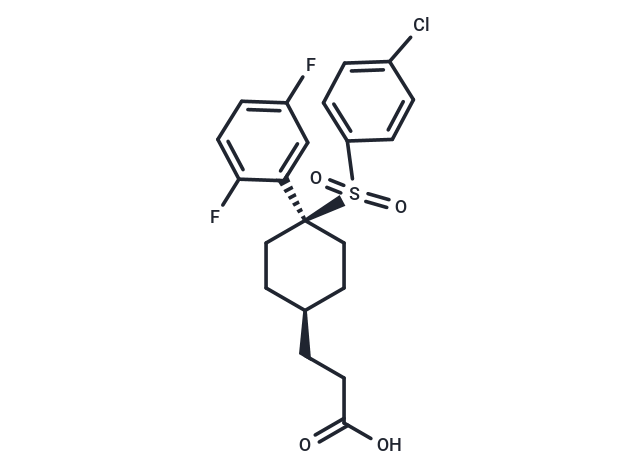Shopping Cart
- Remove All
 Your shopping cart is currently empty
Your shopping cart is currently empty

MK-0752, a γ-secretase inhibitor, reduces Aβ40 production(IC50=5 nM).

| Pack Size | Price | Availability | Quantity |
|---|---|---|---|
| 1 mg | $52 | In Stock | |
| 5 mg | $163 | In Stock | |
| 10 mg | $255 | In Stock | |
| 25 mg | $438 | In Stock | |
| 50 mg | $637 | In Stock | |
| 100 mg | $892 | In Stock | |
| 1 mL x 10 mM (in DMSO) | $179 | In Stock |
| Description | MK-0752, a γ-secretase inhibitor, reduces Aβ40 production(IC50=5 nM). |
| Targets&IC50 | β-Amyloid:5 nM |
| In vitro | In guinea pigs, oral administration of MK-0752 (10-30 mg/kg) resulted in a dose-dependent reduction of Aβ40 in the plasma, brain, and cerebrospinal fluid. Similarly, in monkeys, MK-0752 (240 mg/kg) was capable of reducing the production of Aβ in the brain. |
| In vivo | In human SH-SY5Y cells, MK-0752 significantly reduces Aβ40 in a dose-dependent manner with an IC50 of 5 nM. |
| Kinase Assay | Protein kinase assays : Protein kinase assays are either done in-house by ELISA-based assay methods (Kit, KDR, PDGFRα, and PDGFRβ) or by a radiometric method. In-house ELISA assays used poly(Glu:Tyr) as the substrate bound to the surface of 96-well assay plates; phosphorylation is then detected using an antiphosphotyrosine antibody conjugated to HRP. The bound antibody is then quantitated using ABTS as the peroxidase substrate by measuring the absorbance at 405/490 nm. All assays uses purified recombinant kinase catalytic domains that are either expressed in insect cells or in bacteria. The Kit and EGFR protein used for in-house assays are prepared internally; other enzymes are obtained. Recombinant Kit protein is expressed as an NH2-terminal glutathione S-transferase fusion protein in insect cells and is initially purified as a nonphosphorylated (nonactivated) enzyme with a relatively high Km for ATP (400 μM). In some assays, an activated (tyrosine phosphorylated) form of the enzyme is prepared by incubation with 1 mM ATP for 1 hour at 30 °C. The phosphorylated protein is then passed through a desalting column to remove the majority of the ATP and stored at ?80 °C in buffer containing 50% glycerol. The resultant preparation has a considerably higher specific activity and a lower Km for ATP (25 μM) than the initial nonphosphorylated preparation. The inhibition of Kit autophosphorylation by OSI-930 is assayed by incubation of the nonphosphorylated enzyme at 30 °C in the presence of 200 μM ATP and various concentrations of OSI-930. The reaction is stopped by removal of aliquots into SDS-PAGE sample buffer followed by heating to 100 °C for 5 minutes. The degree of phosphorylation of Kit is then determined by immunoblotting for both total Kit and phosphorylated Kit. |
| Molecular Weight | 442.9 |
| Formula | C21H21ClF2O4S |
| Cas No. | 471905-41-6 |
| Smiles | OC(=O)CC[C@H]1CC[C@@](CC1)(c1cc(F)ccc1F)S(=O)(=O)c1ccc(Cl)cc1 |
| Relative Density. | 1.361 g/cm3 |
| Storage | Powder: -20°C for 3 years | In solvent: -80°C for 1 year | Shipping with blue ice. | |||||||||||||||||||||||||||||||||||
| Solubility Information | H2O: < 1 mg/mL (insoluble or slightly soluble) DMSO: 89 mg/mL (200.94 mM) Ethanol: 45 mg/mL (101.6 mM) | |||||||||||||||||||||||||||||||||||
Solution Preparation Table | ||||||||||||||||||||||||||||||||||||
Ethanol/DMSO
| ||||||||||||||||||||||||||||||||||||

Copyright © 2015-2024 TargetMol Chemicals Inc. All Rights Reserved.